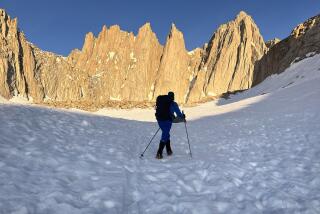A Sometimes Lethal Siren Song
- Share via
Never has a mountaineering disaster received such attention, or criticism, as the one that occurred on Mt. Everest one year ago. But then it is Everest, at 29,028 feet the world’s highest peak.
Climbers in several parties were trapped by a vicious storm high on the mountain on May 10, 1996. Eight lost their lives in the tempest, and four others died on the mountain before the month was out.
How could it happen? What can be done to prevent it from happening again?
There were cries in some quarters for new regulations, particularly to cover guide services that had promised wealthy clients that, for a $65,000 fee, they would be virtually assured of reaching the highest point on Earth. Activities at lower levels might indeed be constrained by rules, but it’s doubtful that ever will be so at 29,000 feet.
And here it is, May again, the heart of the climbing season in the Himalayas, and the demand for spots on the limited number of commercial expeditions to Everest may well turn out to be stronger than ever.
“Everest is something special,” says Jon Krakauer, a Seattle climber-writer who made the summit last year and who chronicles the ordeal in his book, “Into Thin Air.”
“And if you don’t understand Everest and appreciate its mystique, you’re never going to understand this tragedy and why it’s quite likely to be repeated,” he noted in a magazine article.
Truth is, there always has been far more to climbing Mt. Everest than the mere fact that it is there.
More to Read
Sign up for The Wild
We’ll help you find the best places to hike, bike and run, as well as the perfect silent spots for meditation and yoga.
You may occasionally receive promotional content from the Los Angeles Times.






